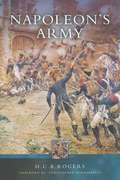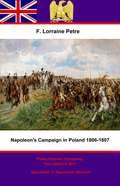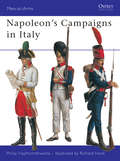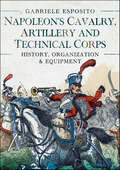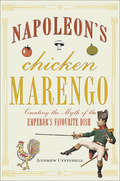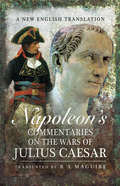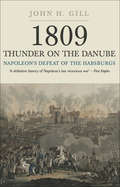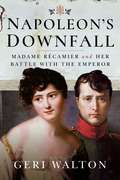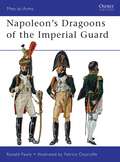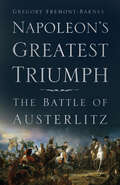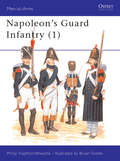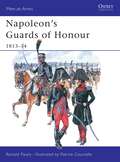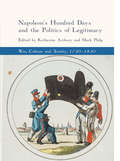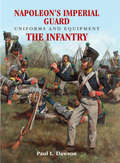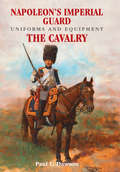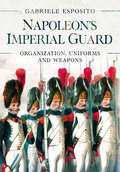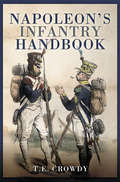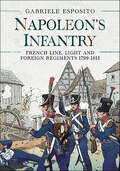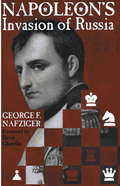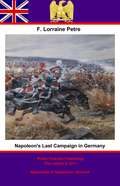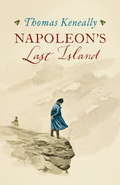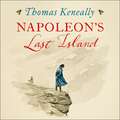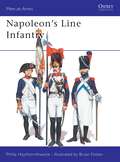- Table View
- List View
Napoleon's Army
by H. C. RogersMany books have been written about Napoleon and his campaigns, but very little about the soldiers of his armies and of the organization and conditions under which they lived and served. In this classic study, now reissued in paperback, H.C.B. Rogers examines Napoleon's army in terms of its staff systems, its arms and its supporting services as it existed and changed during the long period that separated the battles of Valmy and Waterloo. This is not another history of Napoleon's campaigns. Apart from the brief narrative of the opening chapter designed to serve as an aide-memoire, military operations are only cited to illustrate organization, tactics, equipment and administration. The author seeks to show how, as Lord Wavell put it, Napoleon inspired 'a ragged, mutinous, half-starved army and made it fight as it did'.
Napoleon's Army in Russia: The Illustrated Memoirs of Albrecht Adam, 1812
by Jonathan NorthIn 1812 Napoleon's magnificent army invaded Russia. Among the half a million men who crossed the border was Albrecht Adam, a former baker, a soldier and, most importantly for us, a military artist of considerable talent. As the army plunged ever deeper into a devastated Russia Adam sketched and painted. In all he produced 77 colour plates of the campaign and they are as fresh and dramatic as the day they were produced. They show troops passing along dusty roads, bewildered civilians, battles and their bloody aftermath, burning towns and unchecked destruction. The memoirs which accompany the plates form a candid text describing the war Adam witnessed. Attached to IV Corps, composed largely of Italians, he was present at all the major actions and saw the conquerors march triumphantly into Moscow. But, from then on, the invading army's fate was sealed and the disastrous outcome of the war meant that the year 1812 would become legendary as one of the darkest chapters in history.
Napoleon's Campaign in Poland, 1806–1807
by Pickle Partners Publishing Francis Loraine Petre O.B.EThis ebook is purpose built and is proof-read and re-type set from the original to provide an outstanding experience of reflowing text for an ebook reader. F. Lorraine Petre was at the forefront of a number of British historians who wrote at the turn of the 20th Century who advanced the knowledge, understanding of Napoleonic times and warfare hugely. Petre wrote a number of books on the subject, particularly because of the dearth of information focusing on Napoleon's "lesser-known" campaigns, with a depth of research unheard of at the time. His writings have stood the test of time and have been re-printed a number of times, as recently as the last ten years. In this book his second in his series, shines the spotlight of the Napoleon's quest to vanquish his last remaining continental enemy, Russia. Having smashed Prussia in 1806, Napoleon eagerly sought out his Russian opponents, however his tactics of lightning advances and strategic envelopment founded in the mud and cold of Poland. Extended over a vast area, his troops acutely suffered from shortages and played a deadly game of cat and mouse with the last of the Prussian forces under Lestocq whilst waiting for the thaw that would enable them to come to grips with the enemy. As it transpired they did not have to wait as long as they might have imagined, fighting the bloody slugging match in the snow with the Russians at Eylau and although they held the field, it was a field covered by their own comrades' corpses. After another brutal but more successful engagement at Heilsberg, during which the Russians lost heavily, Napoleon finally ran his quarry to the ground at Friedland. After a sterling delaying action by Lannes' corps and supporting cavalry under Grouchy, Napoleon found his opponent pinned with his back to a river. After an abortive attack by Marshal Ney, General Sènarmont drove a battery of thirty guns into canister range of the Russian centre leaving a red ruin, and allowing a victory for the French turn into a bloody rout for the Russians as many drowned trying to reach their lines on the other side of the river. The peace of Tilsit was to be signed soon after, marking arguably the highpoint of the French Empire. Author - Francis Lorraine Petre OBE - (1852-1925) Text taken, whole and complete, from the edition published in 1901, London, Sampson, Low and Company. Original - 339 pages. MAPS - due to their size have not been included Linked TOC
Napoleon's Campaigns in Italy
by Richard Hook Philip HaythornthwaiteIn January 1794 the French 'Army of Italy' was commanded by General Dumerbion and he acknowledged a great debt to his 25-year-old commander of artillery - Napoleon Bonaparte. The French Revolution had resulted in major changes in the military system, conscription created a national army and new tactics and initiatives allowed an officer of such promise as Napoleon to rise quickly through the ranks. By 1796 he was the general commanding the French in Italy and at the conclusion of fourteen months campaigning he was the decisive military personality of his age. Philip Haythornthwaite examines Napoleon's campaigns in Italy, and the uniforms of his soldiers are illustrated in eight colour plates by Richard Hook.
Napoleon's Cavalry, Artillery and Technical Corps 1799–1815: History, Organization and Equipment
by Gabriele EspositoThe French Army of Napoleon could count on a brilliant mounted arm, consisting of three main types of cavalry: heavy, medium and light. The first, consisting of carabiniers and cuirassiers, was tasked with conducting frontal charges; the second, consisting of dragoons and lancers, could perform a variety of different duties; the third, consisting of hussars and mounted chasseurs, was tasked with scouting and skirmishing. The various regiments were all dressed in flamboyant uniforms and distinctive equipment. Perhaps more than any other troops they encapsulated the dash and glamour of Napoleonic warfare. Napoleon started his military career as an artillery officer and thus always paid great attention to the quality of his army’s artillery, which consisted of both foot and horse units. Several of Bonaparte’s greatest victories were achieved thanks to the superiority of his artillery, which was with undoubtedly the best in Europe during the period 1799-1815. In addition to cavalry and artillery, the author also covers the minor ‘technical corps’ of Napoleon’s army, such as the engineers and supply train. All are beautifully illustrated by the many color plates in this book, and their organization, equipment and tactics described.
Napoleon's Chicken Marengo: Creating the Myth of the Emperor's Favourite Dish
by Andrew UffindellThis remarkable work tells the story of Chicken Marengo, and cuts through the tangle of myths that has sprung up around it. Supposedly created on the evening of Napoleons victory at Marengo, the dish rapidly conquered Paris, and became a renowned symbol of French haute cuisine.The author sets the dish in its context explaining the nail-biting drama of Napoleons Marengo campaign and the remarkable frenzy of rejoicing unleashed in Paris by the news of his victory. The author argues that the dish is part of a wider myth that Napoleon spun around the battle itself. Uncomfortably aware of just how close he had come to disaster, he rewrote the official account of Marengo. Determined to exploit the political impact of the victory to the full, he portrayed it as a masterly maneuver, rather than a near-defeat salvaged largely by luck.Napoleons Chicken Marengo demonstrates the persistency of popular myth in shaping perceptions of pivotal events. Uffindel sheds startling light on Napoleons extraordinary and yet elusive character, and reveals just how effectively he spun a myth around the amount of food he ate in order to project a positive image of himself. A whole cast of other, unforgettable characters enlivens the story of Chicken Marengo, from Napoleons bickering generals, to celebrity chefs, colorful adventurers, acclaimed artists, fabulously wealthy eccentrics, and famous writers such as William Makepeace Thackeray.
Napoleon's Commentaries on the Wars of Julius Caesar: A New English Translation
by R A MaguireWhile in exile on St Helena, Napoleon dictated a commentary on the wars of Julius Caesar, later published in 1836. In each chapter he summarized the events of one campaign, then added comments from the standpoint of his own military knowledge. Over the nearly two millennia between Caesar and Napoleon some aspects of warfare had changed, notably the introduction of firearms. But much remained the same: the rate of movement of armies (at the foot pace of horse or man); human muscle power as the main source of energy for construction work; some military techniques, notably bridge construction; as well as the actual territory fought over by Caesar and later by Napoleon. Napoleons commentary thus provides a fascinating and highly authoritative insight into Caesars wars, as well as providing a window into Napoleons own thinking and attitudes. Napoleon in places detects mistakes on the part of Caesar and his enemies, and says what they should have done differently. Remarkably, this is thought to be the first full English translation of Napoleon's work.Napoleon Bonaparte was born to an obscure Corsican family but rose through the ranks of the French army to become Emperor of France, conqueror of most of Europe and acknowledged military genius. He wrote this book while in exile on St Helena.The translator. RA Maguire, is a former civil engineer with a long-standing interest in military and ancient history.
Napoleon's Defeat of the Habsburgs: Napoleon's Defeat of the Habsburg, Vol I (1809: Thunder on the Danube #1)
by John H. GillThis history of the 1809 Franco-Austrian War presents an in-depth chronicle Napoleon&’s last great victory. On April 10th, 1809, while Napoleon was occupied in Western Europe with the Peninsular War, the Austrian Empire launched a surprise attack that sparked the War of the Fifth Coalition. Though France would ultimately win the conflict, it would be Napoleon&’s last victorious war. Even then, the margin of French superiority was decreasing. Archduke Charles, the best of the Habsburg commanders, led a reformed Austrian Army that was arguably the best ever fielded by the Danubian Monarchy. Though caught off guard, the French Emperor reversed a dire strategic situation with stunning blows that he called his 'most brilliant and most skillful maneuvers'. Following a breathless pursuit down the Danube valley, Napoleon occupied the palaces of the Habsburgs for the second time in four years. He would win many battles in his future campaigns, but never again would one of Europe's great powers lie broken at his feet. In Thunder on the Danube, historian John H. Gill tackles the political background of the war, including the motivations behind the Austrian offensive. Gill also demonstrates that 1809 was both a high point of the First Empire as well as a watershed, for Napoleon's armies were declining in quality and he was beginning to display the corrosive flaws that contributed to his downfall five years later. His opponents, on the other hand, were improving.
Napoleon's Downfall: Madame Récamier and Her Battle with the Emperor
by Geri WaltonAn account of the wealthy socialite who opposed the French emperor and found herself exiled from Paris—from the author of Marie Antoinette’s Confidante.Napoleon Bonaparte and Juliette Récamier were both highly influential and well-known in France, yet they were often at odds with each other. Their story played out on the European stage during a period of political upheaval and new political ideas. Napoleon gained power in the aftermath of the French Revolution, and he would go from spectacular victories to dismal failure. His defeat in the early nineteenth century would result in Europe acquiring new national borders and with that Britain, Russia, and the United States would gain greater international influence.Juliette, on the other hand, wielded her own power. Because of the tumultuous French Revolution, noble and aristocratic landowners were being replaced by a new wealthy class in the private sector. Juliette and her husband were among the beneficiaries of this growing affluence and influence, and her power came from her newfound position in society.Juliette also viewed life differently than Napoleon. She saw life from the standpoint of a wealthy socialite whereas Napoleon’s desires were always shaded by his military experiences and his meteoric rise to power.Along the way, Juliette would have to face the testy Emperor, and she would find that his own brother would fall for her. Even some of Napoleon’s greatest enemies would woo her. “A fascinating look at two of the French Revolution’s most amazing and engaging characters, Napoleon Bonaparte and Juliette Récamier, both of whom wielded enormous power in a most turbulent time.” —Books Monthly
Napoleon's Downfall: Madame Récamier and Her Battle with the Emperor
by Geri WaltonAn account of the wealthy socialite who opposed the French emperor and found herself exiled from Paris—from the author of Marie Antoinette’s Confidante.Napoleon Bonaparte and Juliette Récamier were both highly influential and well-known in France, yet they were often at odds with each other. Their story played out on the European stage during a period of political upheaval and new political ideas. Napoleon gained power in the aftermath of the French Revolution, and he would go from spectacular victories to dismal failure. His defeat in the early nineteenth century would result in Europe acquiring new national borders and with that Britain, Russia, and the United States would gain greater international influence.Juliette, on the other hand, wielded her own power. Because of the tumultuous French Revolution, noble and aristocratic landowners were being replaced by a new wealthy class in the private sector. Juliette and her husband were among the beneficiaries of this growing affluence and influence, and her power came from her newfound position in society.Juliette also viewed life differently than Napoleon. She saw life from the standpoint of a wealthy socialite whereas Napoleon’s desires were always shaded by his military experiences and his meteoric rise to power.Along the way, Juliette would have to face the testy Emperor, and she would find that his own brother would fall for her. Even some of Napoleon’s greatest enemies would woo her. “A fascinating look at two of the French Revolution’s most amazing and engaging characters, Napoleon Bonaparte and Juliette Récamier, both of whom wielded enormous power in a most turbulent time.” —Books Monthly
Napoleon's Dragoons of the Imperial Guard
by Patrice Courcelle Ronald PawlyDressed in distinctive green uniforms and classically inspired copper helmets, the Dragoons of the Imperial Guard were raised in 1806 by the same criteria as other Guard units - by selection of picked, literate veterans from Line regiments who had six to ten years of service, and citations for bravery in at least two campaigns. The following year they were named Dragons de l'Impératrice in a unique compliment to the Empress Josephine. As a ceremonial regiment it enjoyed many privileges, but it also saw combat on a number of occasions, including the battles of Essling and Wagram (1809), the Russian campaign (1812, when it suffered severe losses), at Bautzen, Wachau and Leipzig (1813), in the 1814 Campaign of France, and at Ligny and Waterloo (1815).The unparalleled documentary and pictorial sources to which Ronald Pawly has access inform this, the latest volume in his unique English-language coverage of the cavalry of Napoleon's Imperial Guard. It includes a history of the unit's organisation and service, uniforms and equipment, drawn from the original manuscript correspondence of Napoleon and his senior officers, orders and inspection reports, which survive in the Paris archives to this day. Interspersed with material on the records of particular individuals - their promotions, wounds and deaths in action - and illustrated with uniform prints, photographs of portraits and colour plates covering all ranks and orders of dress, this is the definitive history of a legendary Napoleonic regiment.
Napoleon's Greatest Triumph: The Battle of Austerlitz
by Gregory Fremont-BarnesIN AUGUST 1805, Napoleon abandoned his plans for the invasion of Britain and diverted his army to the Danube Valley to confront Austrian and Russian forces in a bid for control of central Europe. The campaign culminated with the Battle of Austerlitz, regarded by many as Napoleon’s greatest triumph, whose far-reaching effects paved the way for French hegemony on the Continent for the next decade. In this concise volume, acclaimed military historian Gregory Fremont-Barnes uses detailed profiles to explore the leaders, tactics and weaponry of the clashing French, Austrian and Russian forces. Packed with fact boxes, maps and more, Napoleon’s Greatest Triumph is the perfect way to explore this important battle and the rise of Napoleon’s reputation as a supreme military leader.
Napoleon's Guard Infantry
by Bryan Fosten Philip HaythornthwaiteThe concept of the bodyguard is as ancient as the practice of an individual assuming the leadership of a group or tribe. From the Companions of Alexander to the Varangians of Byzantium, bodies of élite warriors, owing personal allegiance to their sovereign and obeying no others, have illuminated or stained the annals of military history. Napoleon's Imperial Guards probably represent the last true link in a chain spanning the ages. Philip Haythornthwaite describes the history, organization and equipment of Napoleon's Guard Infantry during the Napoleonic Wars period (1799-1815) in an engaging work which includes numerous illustrations and eight full page color plates superbly drawn by Bryan Fosten.
Napoleon's Guards of Honour
by Patrice Courcelle Ronald PawlyOne of the least understood of Napoleon's corps were the four regiments of Gardes d'honneur, raised in 1813 during the frantic rebuilding of the French cavalry after the huge losses in Russia. Recruited from the leading social classes, uniformed and equipped at their own expense, and accompanied by servants to take care of such unpleasant chores as stable duty, these men were promised commissions as officers after a year's service in the ranks. Though spectacularly unready for combat upon their arrival with the army, the Guards of Honour would gain skill and confidence while serving alongside the élite cavalry of the Imperial Guard in the campaigns of Saxony and France, 1813-14, and distinguished themselves in battle at Hanau and Rheims. The story of their organisation, uniforms and service during the Napoleonic Wars (1799-1815) is researched from rare archives and memoirs, and illustrated with portraits, surviving uniform items, and meticulous colour plates.
Napoleon's Hundred Days and the Politics of Legitimacy
by Mark Philp Katherine AstburyThis book examines the politics of legitimacy as they played out across Europe in response to Napoleon’s dramatic return to power in France after his exile to Elba in 1814. Napoleon had to re-establish his claim to power with initially minimal military resources. Moreover, as the rest of Europe united against him, he had to marshal popular support for his new regime, while simultaneously demanding men and money to back what became an increasingly inevitable military campaign. The initial return – known as ‘the flight of the eagle’ – gradually turned into a dogged attempt to bolster support using a range of mechanisms, including constitutional amendments, elections, and public ceremonies. At the same time, his opponents had to marshal their resources to challenge his return, relying on populations already war-weary and resentful of the costs they had had to bear. The contributors to this volume explore how, for both sides, cultural politics became central in supporting or challenging the legitimacy of these political orders in the path to Waterloo.
Napoleon's Imperial Guard Uniforms and Equipment. Volume 1: The Infantry
by Paul L. DawsonThe author of Battle for Paris 1815 examines the uniforms and equipment of the infantry of Napoleon&’s Imperial Guard. From its origins as the Consular Guard of the French Republic, and as Napoleon&’s personal bodyguard, the Imperial Guard developed into a force of all arms numbering almost 100,000 men. Used by Napoleon as his principal tactical reserve, the Guard was engaged only sparingly, being deployed at the crucial moment of battle to turn the tide of victory in favor of the Emperor of the French. Naturally, the Imperial Guard has been the subject of numerous books over many decades, yet there has never been a publication that has investigated the uniforms and equipment of the infantry of the Imperial Guard with such detail and precision. The author has collected copies of almost all the surviving documents relating to the Guard, which includes a vast amount of material regarding the issuing of dress items, in some instances down to company level. This information is supported by an unrivaled collection of illustrations, many of which have never been published before, as well as images of original items of equipment held in museums and private collections across the globe. In addition, the renowned military artist, Keith Rocco, has produced a series of unique paintings commissioned exclusively for this book. This glorious book is, and will remain, unsurpassed as the standard work on the clothing and equipment of the Imperial Guard, and will not only be invaluable to historians, but also reenactors, wargamers and modelers. It is one of the most important publications ever produced on this most famous of military formations.
Napoleon's Imperial Guard Uniforms and Equipment. Volume 2: The Cavalry
by Paul L. DawsonThe author of Battle for Paris 1815 examines the uniforms and equipment of the cavalry of Napoleon&’s Imperial Guard. Few military formations have attracted more attention than Napoleon&’s Imperial Guard, and fewer still have been so extravagantly clothed and accoutered with the finest materials and the brightest colors. On both campaign and parade, the Guard, and especially the cavalry regiments, provided a dazzling display of military grandeur. From the green and gold trappings of the Chasseurs à Cheval, to the multicolored Mamelukes, the Guard cavalry was among the most brilliantly dressed formations ever to grace the field of battle. In compiling this magnificent volume, the author has collected copies of almost all the surviving documents relating to the Guard, which includes a vast amount of material regarding the issuing of dress items, even in some instances down to company level. This information is supported by around 100 contemporary prints, many of which have never been published before, as well as images of original items of equipment held in museums and private collections across the globe. In addition, the renown military artist, Keith Rocco has produced a series of unique paintings commissioned exclusively for this book. This glorious book is, and will remain, unsurpassed as the standard work on the clothing and equipment of the cavalry of the Imperial Guard. It is sure to be treasured by reenactors, wargamers, and modelers, as well as historians and enthusiasts as one of the most important publications ever produced on this most famous of military formations.
Napoleon's Imperial Guard: Organization, Uniforms and Weapons
by Gabriele EspositoA detailed analysis of the organization, uniforms and weapons of the French Imperial Guard created by Napoleon I. The author describes how this large military body evolved from the Consular Guard created by Bonaparte as early as 1799 and how this came to include dozens of different military units belonging to each branch of service (infantry, cavalry, artillery, specialist corps). The Imperial Guard was a 'miniature army' made up of veteran soldiers, who were dressed with the most spectacular and elegant uniforms ever seen on the battlefields of Europe. The Guard also included several 'exotic' non-French units that are also covered in the text: Egyptian Mamelukes, Polish and Lithuanian lancers, Tatar scouts, Dutch grenadiers and lancers. The way in which Napoleon employed the Guard in battle is discussed and also how it differed from the rest of the French Army in terms of military dress and weaponry.
Napoleon's Infantry Handbook
by T. E. CrowdyWhat did Napoleon's soldiers carry in their backpacks? A unique reference that paints a detailed picture of one of history&’s great military machines. Napoleon's Infantry Handbook is an essential reference guide, filled with fascinating detail on the training, tactics, equipment, service, and administration of Napoleon's infantry regiments. Based on training manuals, regulations, and orders of the time, it details the everyday routines and practices that governed the imperial army up to the Battle of Waterloo and made it one of history's most formidable military machines. Through years of research, Terry Crowdy has amassed a huge wealth of information on every aspect of the infantryman&’s existence: weapons drill and maintenanceuniform regulationspaydiet and cooking regulationshygiene and latrine diggingmedical careburial of the deadhow to apply for leave, and more This remarkable book fills in the gaps left by campaign histories and even eyewitness memoirs, which often omit such details. This book doesn't merely recount what Napoleon's armies did, it explains how they did it in a world so different from our own. The result is a unique guide to the everyday life of Napoleon's infantry soldiers—as well as an outstanding reference for anyone writing about this historical period.
Napoleon's Infantry: French Line, Light and Foreign Regiments 1799–1815
by Gabriele EspositoThis volume covers the infantry units of Napoleon’s Imperial Army, during the crucial years 1800-1815. When the future Emperor assumed control of France, the infantry of his army was disorganized and poorly equipped; it lacked discipline and was trained in a quite old-fashioned way. Napoleon acted very rapidly to resolve the major problems of his foot troops, by giving them a new structure and by teaching them new tactics. By 1805, the French infantry was without a doubt the best in the world in terms of combat capabilities. The book will cover all the categories of units that were part of Napoleon’s infantry: line regiments, light regiments, foreign corps and special corps. It is not always realized that the French infantry of 1800-1815 included large numbers of foreign soldiers and even an Irish Legion; all these little-known corps are taken into consideration, together with several special corps like Corsican light infantry and mountain infantry. Gabriele Esposito provides a complete guide to the French infantry of Napoleon, illustrated with rare contemporary uniform plates that have never been published before.
Napoleon's Invasion of Russia
by George NafzigerWidely-regarded as one of America's greatest historians, Dodge's work on Napoleon's invasion of Russia in 1812 is without parallel for scholarship or psychological sophistication. Beginning with Napoleon's doomed march on Russia, Dodge traces Napoleon's state of mind and the factors behind his decisions using personal letters and genuine reports. How could Napoleon, such a proficient strategist, have led his army into such an atrocious situation and underestimated the severity of the Russian winter? In one of the most imposing invasions ever attempted - Napoleon could draw upon 600,000 men and 250,000 horses - the Grande Armee's success seemed inevitable. Few could imagine that only 100,000 would reach Moscow and all without having achieved the decisive battle that Napoleon sought - one of the greatest disasters of military history was in the making. Dodge sheds new light on Napoleon's character as a soldier by focusing on his personal matters and behavior, putting aside his political concerns. The narrative provides the perfect introduction for those who want to learn more about Napoleon and the disastrous winter of 1812, as well as for the more seasoned Napoleonic scholar.
Napoleon's Last Campaign in Germany
by Pickle Partners Publishing Francis Loraine Petre O.B.EThis ebook is purpose built and is proof-read and re-type set from the original to provide an outstanding experience of reflowing text for an ebook reader. Having escaped the disaster of the Russian campaign of 1812, Napoleon set out to defeat a coalition of epic proportions, who had coalesced to change the French preponderance of power on the Continent. Leaving his stepson Eugène with the shattered remnants of the Grande Armée in northern Germany, Napoleon's great organisation skills would be used to the full to replace his depleted ranks. Short of cavalry, to scout and follow up any victory and with in-experienced troops, Napoleon struck at the Allied armies with vigour and energy, not wholly seconded by his subordinates. The battles of Lützen and Bautzen proved that he had the will and drive to beat his opponents, but time was running out. As losses mounted, including Grand Marshal of the Palace Duroc and Marshal Bessières, Napoleon could not hope to be everywhere at once. Oudinot was beaten at Gross-Beeren, Vandamme was destroyed at Kulm, Macdonald defeated on the Katzbach and Ney at Dennewitz, the hopes of the French were also brutally dashed by the Austrians joining the ranks of their enemies. The dénouement would be the largest battle known to man at that point in history, fought over three days the battle of Leipzig was rightly known as the "Battle of Nations", two thousand cannon and nearly six hundred thousand men would pound, charge, fire, and die to change the face of Europe. Continuing on in the series of books, after Napoleon and the Archduke Charles, Petre's monumental summation of the 1813 campaigns in Germany is still relevant fresh and excellently researched, balanced. Author - Francis Lorraine Petre OBE - (1852-1925) Text taken, whole and complete, from the edition published in 1902, London, by John Lane, The Bodley Head. Original - 441 pages. MAPS - due to their size have not been included [4 A3]
Napoleon's Last Island
by Thomas KeneallyOn the island of St Helena in the south Atlantic ocean, Napoleon spends his last years in exile. It is a hotbed of gossip and secret liaisons, where a blind eye is turned to relations between colonials and slaves.The disgraced emperor is subjected to vicious and petty treatment by his captors, but he forges an unexpected ally: a rebellious British girl, Betsy, who lives on the island with her family and becomes his unlikely friend.Based on fact, Napoleon's Last Island is the surprising story of one of history's most enigmatic figures and a British family who dared to associate with him. It is a tale of vengeance, duplicity and loyalty, and of a man whose charisma made him dangerous to the end.
Napoleon's Last Island
by Thomas KeneallyOn the island of St Helena in the south Atlantic ocean, Napoleon spends his last years in exile. It is a hotbed of gossip and secret liaisons, where a blind eye is turned to relations between colonials and slaves.The disgraced emperor is subjected to vicious and petty treatment by his captors, but he forges an unexpected ally: a rebellious British girl, Betsy, who lives on the island with her family and becomes his unlikely friend.Based on fact, Napoleon's Last Island is the surprising story of one of history's most enigmatic figures and a British family who dared to associate with him. It is a tale of vengeance, duplicity and loyalty, and of a man whose charisma made him dangerous to the end.
Napoleon's Light Infantry
by Bryan Fosten Philip HaythornthwaiteAlthough light infantry tactics formed one of the cornerstones of the Napoleonic Wars (1799-1815), their employment was by no means restricted to Light regiments. Thus, from the early 1800s, if not before, the distinction between Light and Line infantry was largely one of costume and tradition. One marked difference from the Line infantry, however, was in the superior ésprit de corps of the Light regiments. Their attitude of superiority was reinforced by their different (and often more impressive) uniform, the theoretical difference in role, and supposed superior training. Philip Haythornwaite examines their uniforms in a volume including eight superb colour plates by Brian Fosten.
